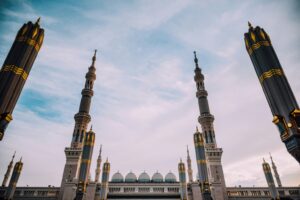When most people think of radar sensors, they envision weather forecasting equipment tracking rain, snow, or approaching storms. While radar’s meteorological applications are indeed crucial, radar technology goes far beyond predicting the weather. In this post, we’ll take a closer look at radar sensors, the different types available, how they work, and their diverse range of applications.
What is radar?
Radar stand for ‘Radio Detection And Ranging.’ It’s a method involving the active transmission and reception of radio waves in the microwave GHz range. Radar sensors employ these waves to detect the distance, angle and velocity of one or more objects, relative to the radar system, without physical contact.
How does Radar Sensors work?
At its core, a radar system consists of a transmitter, which generates radar signals, and an antenna, which transmits these signals and receives echoes from objects in the radar’s field of view. The received signals are then processed by a receiver and further analyzed by a signal processor to identify and measure targets while filtering out background noise.
Radar sensors operate based on the principle of emitting radio waves, which then bounce off objects and return to the sensor. The time it takes for the radar waves to bounce back to the sensor and the frequency shift of the returning waves provide valuable information about surrounding objects.
Types of Radar Sensors
Radar sensors come in various types, each designed for specific purposes. The most common types include:
Doppler Radar
This type of radar relies on the Doppler effect to measure the velocity of moving objects at a distance. It does this by analyzing the frequency shift of the radar waves reflected off them. It is widely used in weather forecasting for tracking precipitation and wind patterns.
Ground-Penetrating Radar (GPR)
GPR is an instrument designed to send high-frequency, pulsed, electromagnetic waves into the ground and record the reflections to create subsurface images. It’s commonly used in geology, archaeology, and construction to map underground structures and objects.
Airborne Radar
Airborne radar is commonly used in aviation for navigation, weather detection, and terrain mapping and it’s crucial for safe flight operations. This radar operates based on the echo principle. It works by emitting a signal which is reflected by water droplets within the clouds, causing it to bounce back. Subsequently, the receiver gathers these reflected signals and processes them to generate the weather information displayed to pilots.
Synthetic Aperture Radar (SAR)
SAR is a type of active data collection method in which a sensor emits its own energy and records the amount of that energy reflected back after interacting with the Earth’s surface. SAR satellites use radar to capture high-resolution images of the Earth’s surface, making it valuable for applications like agriculture, forestry, and disaster monitoring.
Applications of Radar Sensors
Now, let’s explore the some of the most common applications of radar sensors beyond weather forecasting:
Aviation
Radar is the backbone of aviation safety and efficiency. Air traffic control relies on radar systems to monitor the movement of aircrafts, ensuring safe takeoffs, landings, and routing during flights. Radar is also used for collision avoidance systems, which help prevent mid-air collisions by providing real-time information about nearby aircrafts. Additionally, radar aids in aircraft navigation, especially during adverse weather conditions or in remote areas where ground-based navigation aids are limited.
Automotive Industry
In the automotive industry, radar sensors are integrated into vehicles to enhance safety and driving convenience. They enable adaptive cruise control, which automatically adjusts the vehicle’s speed to maintain a safe following distance from the car ahead. Moreover, radar-based blind-spot monitoring systems alert drivers to the presence of vehicles in their blind spots. These sensors are also integral to autonomous driving technologies, helping vehicles perceive and respond to their surroundings.
Agriculture
Radar, both ground-based and satellite-based, is used in agriculture to monitor and manage various aspects of crop cultivation. Soil moisture measurement using radar helps optimize irrigation, ensuring that crops receive the right amount of water. Radar-based crop monitoring assists in assessing crop health, growth, and yield prediction. Additionally, radar can help predict and manage floods by monitoring soil moisture levels and river water levels.
Environmental Monitoring
Radar sensors are indispensable tools in monitoring and responding to natural disasters. They are crucial for tracking severe weather phenomena like hurricanes, tornadoes, and thunderstorms. Radar data provides valuable information on storm intensity, movement, and precipitation patterns, allowing for early warnings and timely evacuation efforts. In coastal areas, radar helps monitor tidal surges and storm surges during events like tsunamis.
Construction and Infrastructure
GPR technology is crucial in construction and infrastructure projects. It helps detect buried utilities such as water pipes, electrical cables, and gas lines, preventing accidental damage during excavation. GPR is also used to assess the integrity of structures, identifying hidden defects, voids, or deterioration in concrete or other construction materials.
Conclusion
Radar technology is a marvel of engineering that extends far beyond its well-known role in weather forecasting. Its versatility and precision make it indispensable in a multitude of industries and applications.
For organizations seeking to harness the power of radar and extract valuable insights, our AI-powered platform, FlyPix AI, can assist them in efficiently analyzing radar data. With the ability to process and interpret radar information rapidly, organizations can make informed decisions, improve safety, and optimize operations across a wide range of sectors, including aviation, agriculture, and environmental monitoring. To explore the capabilities of FlyPix AI firsthand, don’t hesitate to contact us today.





